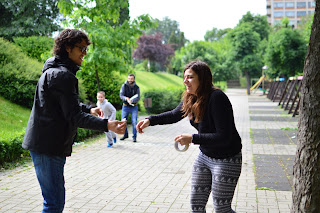TELL
ME AND I FORGET. TEACH ME AND I REMEBER. INVOLVE ME AND I LEARN
ESTEBAN
SÁNCHEZ, Ana
Asociatia
pentru protectia mediului, turism si educatie
Since
I was 18 years old I learned about non formal education throught my experience
as volunteer. The volunteering was focused in a non formal education because of
I spent my time with children and people in social risk. It was during to my
childhood, when I had my first contact with that education way. Thank to my
parents, who teach me to learn, to reserach, to think, throught traveling.
However, until I started my degree, I was be able to name that education way. I
mean, a empirical education. Nevertheless, finished my degree, I made the
decision to go to Arad. To do a European Voluntary Service, to take an
international experience, and finally to put in practise this before background
connected with the education. The tittle of the article remained in my mind
First
of all said that I´m sure I want to be a human rights educator. I did a lot
kind of courses in Spain about it. Why not fight for the human rights throught
the education? Going directly to the school, high schools, institutions, and teach
them, and finally all of us learning together.
Following
my degree, History of Art, I started Spanish Art Conference at Art school of
Arad. That´s the first non formal education experience with the art. I am still
doing it until June. The art can be education too. See and realized how much
the students know what I am talking about during my conferences it´s something
amazing. Give them the chance to think, to envolve them in a conversation, because
it´s the most important way to interact together. All of experience
was done with a powert point back me, because, what can be the best way
to teach art that the pictures? I am talking about a empirial education and
about a picture´s memory. In addition, I don´t want to teach always talking,
without any opportunity for them to express themselves. From my point of view
it´s not teaching.
In
other hand, I did a peace and non violence campaign and a gender equality day
with teenagers and kinds. Fort he first campaign I needed a powert point to
dynamaze my class. I had the chance to know too many teenagers, and more than 30 hours to undestake on three
schools and high schools. Even places with different cultures, so distinct ways
to learn, to teach. I was at German school of Arad. It´was a surprise how they
polite they are, but at the same time, how few they know about the reality,
about wars, violence, people who figh for the peace.
I
try to made them think through videos, Nelson mandela´s speech, and a powert
point too. They didn´t react so well. So I decided to do one step more talking
about my volunteering experience in Guatemala. It´s the best choice. To envolve
them in my experience, to show them what they can do as humans they are. After
the German school conference, I realized how the people need a close experience
to understand deeply a them. To envolve them still was good to educating them
on values.
About
the gender equality scholar day, I should said it was a totally different
experience. My objective was the shame that the peace and non violence
campaign, teach values, but because of the school was distinit, the way to do
it as well. The place, Mihail Eminescu school is a poor school. I kept in mind
it to use the material. None powert point; to interact directly with them. To
make them work drawing, painting and using the imagination. Show them that it´s
not neccesary using too much material to the great labour to educate. For that
seasson I show them the most important women characters in the History throught
papper dols. I also prepare a crossword with main words relationed with the
theme, as suffragist, gender, vote etc. Finally I give then the chance to
imagine a impacting sentence to sum up the seasson. If a teacher do that, the
students will feel useful, and appreciating.
Apart
of that, I am spanish teacher at Liceul Dimitri Tichindeal. It a good way to
bring Spanish culture to Romania. And in this sense to exhibit my own culture
over E.L.E videos, real roles and
facts, read them spanish novels, listining spanish music, spanish gramar etc.
My students are teenagers so I have to do a lot of differents activities because
I dont want them to feel boring. In the end, it´s educate them in spanish
values, and teaching them spanish language. Remarking that two distinct
aspects.
In
the end, I must finish talking about the Picasso´s Project, that I am still
doing. The objectives is teaching Picasso’s art and cubism for children in an
interactive and non-formal way through art. Teach how easy is the cubism for
children with free eyes without prejudice. I would like to summarize my
experience in Romania with the sentence of Benjamin Franklin
which is name after the article.
The Spanish as a second language or, more commonly, Spanish as a Foreign Language (ELE) is a matter which consists of bath teaching Spanish one Students who have a different language as their mother, especially immigrants, tourists, indigenous, Refugees and any other you have the person learn for work , business, diplomacy and cultural curiosity. Currently, the number of students of Spanish as a foreign language in the world is about twenty million.









































